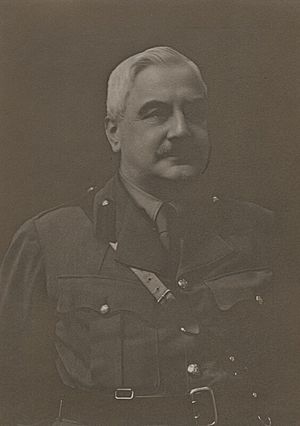John George Adami facts for kids
Quick facts for kids
John George Adami
|
|
|---|---|
 |
|
| Born | 12 January 1862 Manchester, England
|
| Died | 29 August 1926 (aged 64) Liverpool, England
|
| Spouse(s) |
Mary Stuart Cantlie
(m. 1894; died 1916)Marie Wilkinson
(m. 1922) |
| Children | 2 |
| Education |
|
| Medical career | |
| Profession | Physician |
| Field | Pathologist |
| Institutions |
|
| Notable works | Principles of Pathology (1908) |
| Awards |
|
| Military career | |
| Allegiance | |
| Service/ |
Royal Canadian Army Medical Corps |
| Years of service | 1914–1918 |
| Rank | Colonel |
| Battles/wars | World War I |
Prof John George Adami (12 January 1862 – 29 August 1926) was an important English pathologist. A pathologist is a doctor who studies diseases. He was the head of the disease study department at the Royal Victoria Hospital.
From 1892, he was a professor at McGill University in Montreal, Canada. During World War I, he joined the Canadian Army Medical Corps. He became the official historian for their medical branch. Later, starting in 1919, he was the Vice-Chancellor of the University of Liverpool.
Contents
Early Life and Education
John George Adami was born on January 12, 1862. His birthplace was the Ashton upon Mersey area of south Manchester, England. His father, also named John George Adami, owned a local hotel.
He went to Manchester Grammar School and then Owens College in Manchester. After that, he studied medicine at Christ's College, Cambridge. He also did more studies in Breslau (now in Poland) and Paris. He earned high honors in natural science at Cambridge. In 1887, he became a demonstrator of physiology at Cambridge University.
In 1888, he had to get treatment for rabies. He wrote about his experience at the Pasteur Institute's clinic.
Career and War Service
In 1891, he became a fellow at Jesus College, Cambridge. Soon after, he became the head of the pathology department at the Royal Victoria Hospital, Montreal. From 1892, he was a Professor of Pathology at McGill University in Canada.
During World War I, he served in the Canadian Army Medical Corps. He worked in London, helping with medical statistics. He was also chosen to write the history of the Canadian medical service during the war. The first part of his book, The War Story of the Canadian Army Medical Corps, Vol. 1, came out in 1918.
After the war, in 1919, he became the Vice-Chancellor of the University of Liverpool. This is a very important leadership role at a university.
Adami wrote many papers and books about pathology. He published his work in medical journals in different languages. He was chosen as a Fellow of the Royal Society of Edinburgh in 1898. In 1905, he became a Fellow of the Royal Society in London. Being a Fellow of the Royal Society is a great honor for scientists.
He passed away in Liverpool in 1926. He is buried in Allerton Cemetery there.
Family Life
John George Adami married Mary Stuart Cantlie in Montreal in 1894. They had three children together, but only two survived. Mary passed away in 1916. Later, in 1922, he married Marie Wilkinson in Liverpool. Marie lived longer than him.
Scientific Contributions
In 1903, Adami suggested two new words to help classify tumors. Tumors are abnormal growths in the body.
- He used the term lepidic for tumors that seemed to grow along surfaces, like a skin or membrane. Today, this term describes how some tumor cells grow along the surface of lung air sacs.
- He used the term hylic for tumors that seemed to come from basic, undeveloped material.
Awards and Recognition
John George Adami received several important awards and honors for his work:
- 1898: Became a Fellow of the Royal Society of Edinburgh.
- 1905: Became a Fellow of the Royal Society of London.
- 1914: Won the Fothergillian prize from the London Medical Society.
- 1917: Gave the Croonian Lecture at the Royal College of Physicians. This is a very important lecture in medicine.
- 1919: Was awarded the CBE (Commander of the Order of the British Empire). This is a high honor from the British government.
- 1921: Gave the 1st David Lloyd Roberts Lecture at Manchester Royal Infirmary.

